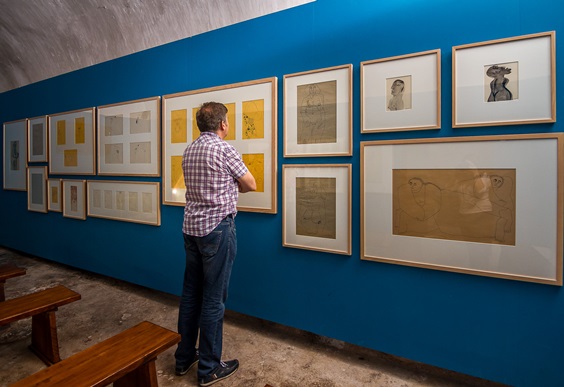The Regional Ministry of Education, Culture and Universities and Aledo City Council have organised the exhibition ‘Notes on an Infinite Figure’ by José María Párraga. Until 14th July, about twenty drawings by the prominent creator from Cartagena will be on view in the Exhibition Room of Aledo Castle.
The exhibition comprises some twenty drawings by Párraga and is part of the project ‘Cultural Routes. Geography of Contemporary Art’, by which the Regional Ministry provides regional City Councils with works of art from ICA’s collection in order to increase the cultural offer in the municipalities.
In ‘Notes on an Infinite Figure’, visitors can view a total of 19 drawings –ink on paper– by Párraga that manifest his constant concern for the human figure: nudes, popular scenes, hidden characters, monsters and mythological scenes, among others. All these pieces were drawn by the artist in the last century between the 60s and the 90s.
The Exhibition Room of Aledo Castle can be visited until 14th July with opening hours as follows: during May it is open from Monday to Sunday, from 11 am to 1.30 pm; and from 1st June onwards, same schedule, but from Monday to Friday.
Career
José María Párraga (Alumbres, Cartagena, 1937 –Murcia, 1997) began his studies in Education in 1951, combining it with his classes at the School of Arts and Crafts in Murcia, where he was trained by such eminent teachers as José María Almela Costa, Luis Garay, Clemente Cantos and Mariano Ballester.
Later on, he lived for some time in Madrid, where he engaged with other painters such as Manolo Valdés. He travelled to Holland and France and there he came into contact with works by Post-impressionists, which exerted great influence on his own work.
In 1955, Párraga started to work as a teacher, a profession he left due to his lack of vocation. He carried out his first individual exhibition in 1956 and some years later, in 1964, became a founding member of the AUNAR, a group of artists like the painters Manuel Avellaneda and Aurelio Pérez Martínez and sculptors Elisa Séiquer, Francisco Toledo Sánchez, José Toledo Sánchez and José Hernández Cano, spurring the renewal of the artistic panorama in Murcia.
Over the course of his long career, Párraga applied various techniques such as drawing, pyrography or even press illustrations. His first works are figurative but show some level of deformation or elongation. From 1959 onwards he began to experiment with collage and applied techniques related to the graphic arts and around 1968 the extent of Picasso and Klee’s influence was clear, inspiring him to create a series of monstrous figures. In the eighties, he suffered an emotional crisis and worked with broken lines, but from the nineties he experienced a more balanced stage and recovered his distinctive curved and winding lines, also incorporating colour.
